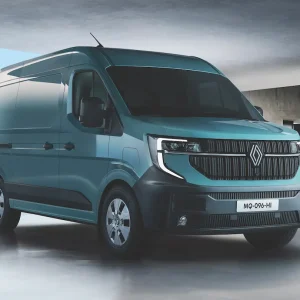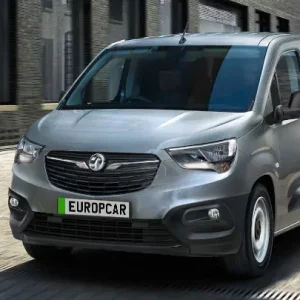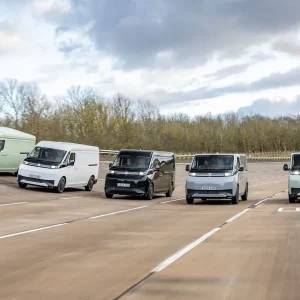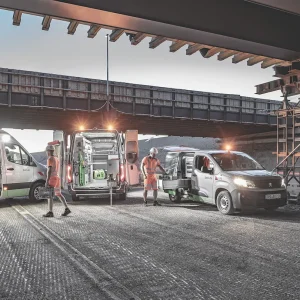Like van owners, minibus operators are having to think about cutting exhaust emissions or eliminating them entirely.
Among organisations leading this development are Kent County Council, with a nine-passenger electric Master Z.E. L2H2 sourced through Renault Trucks. It’s the first battery-powered Master the manufacturer has supplied to a British customer.
Transformed into a wheelchair-accessible passenger carrier in the UK by Renault Trucks-approved converter Minibus Options, it is being operated by Kent-based charity Compaid, which provides services to people with disabilities in the South-East. The council has close links with the charity, and the battery-powered minibus is the first vehicle of its type it has deployed.
The newcomer is being used to transport vulnerable people and people with disabilities from Tunbridge Wells and surrounding areas to Compaid’s training centre in Paddock Wood to learn computer skills. It is also being employed to take them to medical appointments and on shopping trips.
“It’s fantastic we’ve been able to secure this partnership with Renault Trucks so that we can trial an accessible electric minibus,” says Kent County Council cabinet member for transport, Mike Whiting. “We’ve been developing an EVs action plan and the trial will help us prove their viability.”
The Master Z.E.’s 57kW electric motor is powered by a 33kWh lithium-ion battery pack mounted under the floor. It offers a range of approximately 100 miles between recharges, says Minibus Options. The recharge time is around six hours. The seats can be demounted to allow the passenger saloon to be laid out in different ways to meet daily operational requirements. It can be set up to accommodate three seated passengers and up to two wheelchair users, for example, and both the wheelchairs and their occupants can be properly secured.
A fold-down ramp mounted just inside the back doors provides wheelchair access and a floor-mounted winch powered by its own rechargeable battery is fitted to make it easier to pull wheelchairs and the people in them aboard. Using a separate battery means that Master Z.E.’s traction battery is not drained.
Along with zero tailpipe emissions, the silent-running electric motor brings further environmental benefits, says Compaid CEO Stephen Elsden.
“We pick up and drop off in residential areas, so reducing noise pollution in local streets is important,” he observes. “Furthermore, the low noise level is equally valued by the Master Z.E.’s passengers, who see the journey as an integral part of their experience, giving them an opportunity to chat with friends.
“A quiet vehicle is a real asset if you’re having a conversation because you’re not trying to talk over the noise of an engine,” he adds.
Aftersales support is being provided by Renault Trucks Essex in Thurrock, with work scheduled outside normal working hours to maximise uptime.
The Master Z.E. has few direct competitors in the minibus market, but it does not have the sector entirely to itself. At the CV Show earlier this year Mellor Coachcraft was exhibiting the latest version of its battery-powered low-floor 16-passenger Orion E. Using a front end borrowed from Fiat Professional’s Ducato, it comes with a new electric motor producing peak torque of 5,000Nm, which has significantly improved its hill-climbing ability, says Mellor.
Range between battery recharges is up to 120 miles, the company continues, adding that it remains much the same in all weather conditions. Heavy rain and a howling gale can reduce the range of battery vehicles significantly, as can freezing winter temperatures. It takes 4.25 hours to charge up the Orion E’s battery pack, contends Mellor, falling to 2.25 hours if you plug it into a rapid charger.

The electric vehicle Orion E borrows a Fiat Ducato front end

Blue Bus Dailys run on CNG
(Continuted from previous page) East Yorkshire’s Holderness Area Rural Transport (HART) has recently taken delivery of an Orion E as part of a joint-venture with gas and electricity giant E.On and Leader, a rural development programme for England jointly funded by the UK government and the European Union.
“It is running on country routes where the infrastructure for EVs is not as advanced as it is in urban areas,” says HART manager Caroline Wegrzyn.
Iveco has been building an electric version of the Daily minibus for the past 10 years, and the latest model unveiled earlier this year is also produced with battery power.
It boasts a range of either just over 60 or around 100 miles, with either two or three sodium-nickel chloride batteries combined with ultracapacitors that can deliver quick bursts of power. The batteries can be recharged in a couple of hours if you use a rapid charger, says Iveco.
The new Daily minibus can be run on compressed natural gas (CNG) instead, a capability it shares with its predecessor. Believed to be the first CNG minibuses to go into service in the UK, three examples of the previous gas Daily joined Luton-based Blue Bus Innovations last year. They are used to provide a shuttle service from Luton Airport to various pick-up and drop-off points in central London, and back again, between 7am and 11pm daily. Fares start at £7.99 and passengers can pre-book their seats using an app.
All three vehicles are 50C14GA8s Daily Line 16-seaters built on 4.1m wheelbases and powered by 140hp 3.0-litre engines married to Hi-Matic eight-speed automatic gearboxes. They produce 12% fewer NOx emissions and 76% less particulate matter than an equivalent diesel, according to Iveco, and up to 95% less CO2 if you run them on biomethane.
“With emission restrictions set to get even tougher, we will look to increase our fleet of alternative-fuelled minibuses,” says Blue Bus MD Tazio Puri Negri.
Aftersales back-up is being provided by supplying dealer Iveco Retail in Croydon, south London, under an Iveco Elements repair and maintenance package. It has been arranged as part of a five-year lease agreement set up through Iveco Capital.
While electric and CNG minibuses may be attracting publicity, the bulk of minibuses sold in the UK are still diesel-powered. At the same time as acquiring its gas minibuses, Blue Bus put three diesel Daily Tourys 65C18HA8 19-seaters into service with 180hp 3.0-litre engines, Hi-Matic transmissions again, leather-trimmed Kiel Avance seats, and individual passenger aircon vents.
MAN is busy extolling the virtues of a 16-passenger TGE 5.180 converted by Minibus Options and powered by a 180hp 2.0-litre diesel with a six-speed manual gearbox. The passenger saloon can be made wheelchair-accessible and laid out in a variety of different ways: as a 10-seater with room for two wheelchair users, for example, or as a 14-seater with space for just one.
The TGE is virtually the same as Volkswagen’s Crafter apart from its badges, and VW has come up with a Crafter CR50 transformed into a 16-passenger minibus by Northern Ireland’s Taxi Bus Conversions. A rear-mounted inboard Braun Vista lift makes it wheelchair-accessible. VW’s UK minibuses come under its Engineered to Go conversions programme.
Although it was announced not long before the event, the aforementioned Crafter was not displayed on the VW stand at this year’s CV Show. Instead, the company exhibited a CR50 sourced from the same converter and with the same seating capacity, but non-wheelchair-accessible and built to upmarket executive specifications.
Executive class
There is without doubt a demand for executive minibuses, and for minibuses that can be used by the wealthy as chauffeur-driven luxury transport with every conceivable amenity.
Stanford Coachworks can take a Sprinter and do quite remarkable things to its interior under the Monaco banner, installing everything from heated passenger seats that can fully recline and give you a massage to 24-carat gold-plated cupholders. That is in addition to a fridge, a bar, a couple of 40in smart TVs, a Bose surround-sound system … the list is endless, and restricted only by your imagination and your bank balance.

MAN’s TGE minibus

The 16-seat Volkswagen Crafter
(Continuted from previous page) Stanford Coachworks produces more mainstream minibuses too, and is a member of Ford’s Qualified Vehicle Modifier programme along with three other minibus converters: Alfred Bekker API, Lyndon Systems and Voyager MPV.
Ford builds Transit-based minibuses itself and is considerably better at building them than operating them. Earlier this year it shut down the Chariot minibus-based commuter shuttle service it had launched in London 12 months before. Using 14-seater Transits, some of which were wheelchair-accessible, it was set up to offer an alternative to passengers in areas of the capital not all that well served by buses or the tube.
London was the first Chariot operation to appear outside the US. Acquired by Ford in 2016 for a reputed £50m from its founders, who started it in San Francisco in 2014, it was active in a number of major cities in the US, including New York and Los Angeles. All the American operations were shut at the same time as the one in London.
Ford has given no clear explanation as to why it closed Chariot, but tough competition from Uber and similar organisations was probably a key factor.
Ford’s withdrawal is not deterring VW, however. MOIA, the VW group’s mobility services provider, hopes to run an on-demand minibus service in Ealing, London, in conjunction with bus operator RATP Dev using up to 10 L4H3 MAN TGEs. Travellers will be able to book a seat using an app or over the phone. The TGEs will not follow a fixed route, with users instead able to board one at flexible stops within a certain area.
Transport for London recently began a four-week consultation on the plan. “The scheme will help us to understand if a more flexible, on-demand offering will tempt people out of their cars,” says TfL director of transport innovation Michael Hurwitz.
A similar scheme is on trial in Sutton and none of the parties involved appear deterred by what happened to Chariot. “Having trials in two different locations in outer London, with a variety of different travel patterns, will give us a good understanding of whether it is possible to complement the existing bus network in areas that have been traditionally difficult to serve with conventional public transport,” says Hurwitz.
Minibus licensing
You can drive a minibus with up to 16 passenger seats on an ordinary car driver’s licence if you passed your car test on or after 1 January 1997, provided the vehicle is not being operated for hire or reward; you are 21 or older; you are doing so on a voluntary basis; you have held your driving licence for at least two years; if the maximum weight of the minibus is not more than 4.25t including the weight of any wheelchair ramp or lift that may be fitted; and you are not towing a trailer.
If you passed your car test prior to that date then you will probably have a D1 entitlement on your licence. That is the comprehensive minibus licence that among other things allows you to tow a trailer up to a maximum 750kg gross weight.
If you do not have a D1 entitlement, but want one, then you will have to take a separate test.
If the minibus is being operated with the aim of making a profit, however, then you will have to apply for a PCV – a passenger carrying vehicle licence – regardless of whether you have a D1 entitlement or not.
If the organisation running the minibus is doing so on a non-profit-making basis – if it is a church, for example – then it will require a permit issued under Section 19 of the Transport Act 1985, as amended. If it is using a minibus to run a not-for-profit community bus service then it will require a permit issued under Section 22 of the same act.
If payment is taken for carrying passengers with a view to making a profit then the business concerned will need to hold a PSV – public service vehicle – operator’s licence.
Bear in mind that the word ‘payment’ is interpreted quite widely. A private school that charges fees for pupils to attend will probably have to hold an operator’s licence, for example, because pupils are entitled to travel on its minibus as a consequence of fees being paid.





